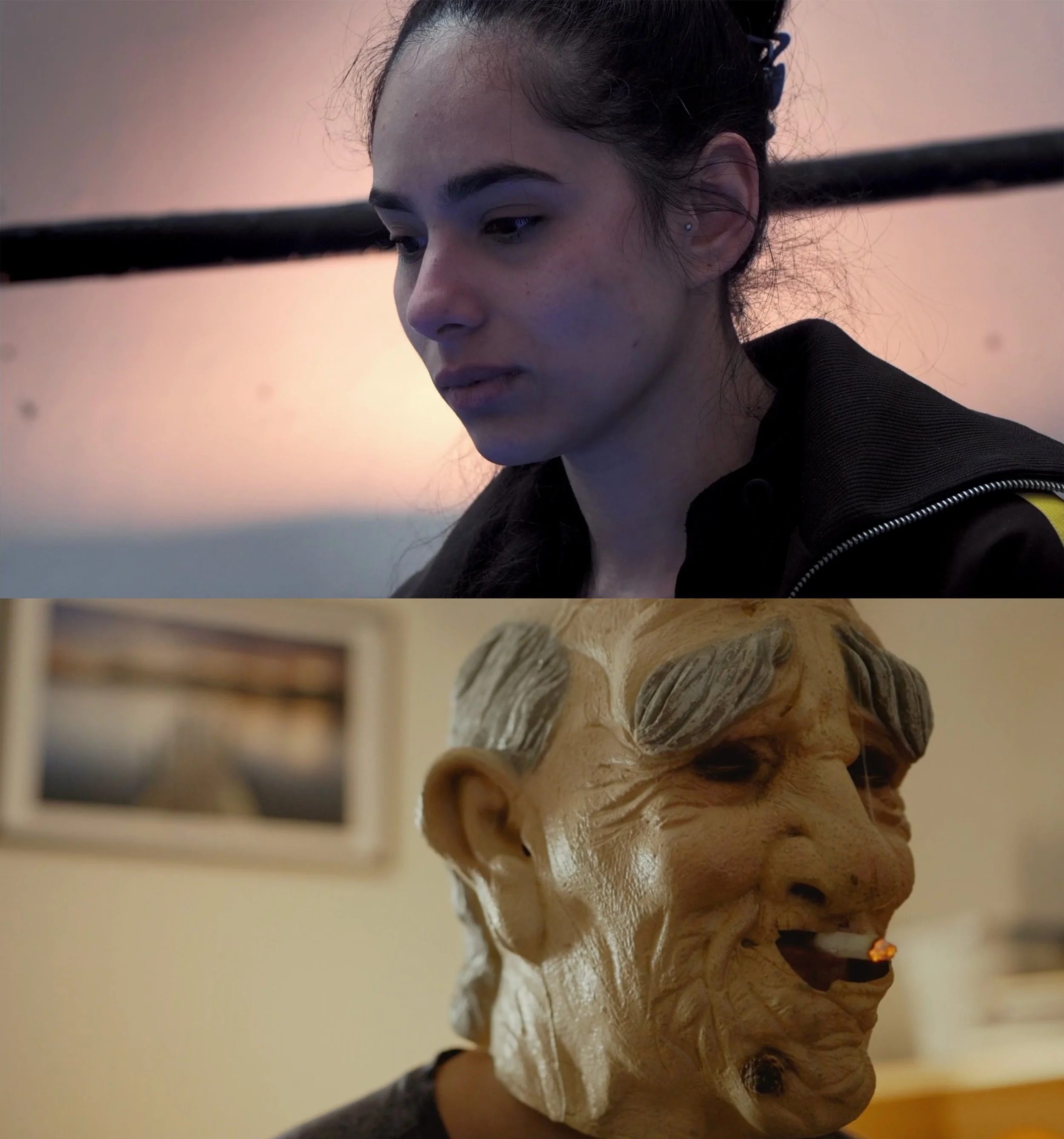research
papers written during my BA and MA studies
Taking a stand – ‘Attitude’ in documentary cinema
year: 2024
language: German
My master’s thesis at Film University Babelsberg KONRAD WOLF examines the idea of “stance” in documentary cinema, especially in films that address controversial debates. It asks how documentaries express their position, not only through explicit director’s commentary but also via other affective-rhetorical means.
The theoretical section explores “stance” through phenomenology, focusing on a film’s “intentionality”, “voice” and “body.” This is illustrated by an analysis of Lord of the Toys by Pablo Ben Yakov and André Krummel, a film criticized for its raw and allegedly uncommented portrayal of right-wing youth in Eastern Germany. I argue that the film’s stance is always present to a certain extent and often communicated through subtle cinematic choices beyond explicit commentary by the filmmakers.
The practical section reflects on my own filmmaking practice during my studies. In Oh, wie frei ist Panama?, I faced the challenge of portraying a conspiracy-theorist without endorsing her views or breaking Bill Nichols’ “pact of trust” with the audience. Here, the film’s stance took shape largely in post-production through the process of montage.
Unleashed Bodies –
On the theory of embodied film perception in Gaspar Noé’s CLIMAX
year: 2019
language: German
This essay argues for a theory of embodied cinematic perception using Gaspar Noé’s visceral fifth feature film CLIMAX as an analytical mainspring. In doing so, the phenomenology of Husserl and Merleau-Ponty, the related theories of cinematic perception by Thomas Morsch and Vivian Sobchack, and Linda Williams' concept of body genres will be of the utmost importance. With an overview of their theoretical contributions, I hope to succeed in finding a convincing position for the inclusion of the somatic and the haptic within film aesthetics, which in turn can defy the primacy of significational models in film theory.
What does the bullshitter care about?
year: 2019
language: English
Is Donald Trump a liar or a bullshitter? Though these terms may be sometimes used interchangeably, they point to essentially distinctive attitudes towards the truth. While the act of lying requires that the liar at least acknowledge the existence of a truth from which he consciously refrains, the act of bullshitting completely disregards the difference in a proposition being true or false in the first place. Another way of putting it, as Harry Frankfurt notes in his seminal essay On Bullshit, would be to say that the liar and the bullshitter are not even playing the same game.
This brings us to the main two questions of this paper: Does the act of bullshitting imply a systematical lack of care for the truth? If so, could bullshitting be considered a form of intellectual vice? In order to answer these questions in any satisfiable way, I will dissect the philosophical concepts of caring, bullshitting and intellectual vice and proceed to apply them in the analysis of a paramount case of bullshit – an interview with the current president of the United States.
Comedy in Nazi-Germany:
Analysis of a scene from Amphitryon (1935)
year: 2018
language: German
The debate over the political function of entertainment is controversial. It bears for instance on the question of whether an "apolitical film" could ever exist or if the term "Nazi cinema" refers to ideologically charged works, like propaganda, or simply to films produced during the Third Reich. As valid as this discussion may be, this paper chooses to focus on two questions regarding the successful comedies of Nazi-Germany: What kind of humor did they offer their audience? Which cinematic tools did they employ to provoke laughter?
As I tackle these questions, I resort to a scene analysis of Amphitryon – Happiness from the Clouds (GER 1935). My goal is to use an emblematic scene as a starting point to derive the elements of staging, dialogue, camera, montage and music which might contribute to the comical and could be possibly found in other films of the same genre and time.
Remaking as Remapping: Film remakes within the framework of cartographic cinema
year: 2017
language: English
As I intend to show in this paper, the mapping dynamics between film and spectator can be more easily grasped in the context of remakes, which rely on the dialectics of repetition and difference to remap older narratives and render hyper-textual films equivalent to palimpsestic maps. In order to show this, I resort to the short analysis of a scene from Star Wars Episode VII: The Force Awakens (USA 2015), which was often perceived as a remix of the whole Star Wars saga, but even more frequently as a remake of its very first film, Star Wars Episode IV: A New Hope (USA 1977).
The powerful gaze: Ideology in narrative cinema according to Baudry and Mulvey
year: 2016
language: German
In the end of the 1960s and beginning of the 1970s, a conspicuous current originated in film theory concerning the political and ideological influence of traditional narrative cinema over its audience. The somewhat consensual thesis within this school of thought tended to portray the spectator as a manipulable subject whose perception was at the mercy of cinema's illusory potentialities. Frequently, these ideas were also influenced by arguments from feminist and psychoanalytical theory.
Among the most prominent representatives of this current, the French Jean-Louis Baudry and the British Laura Mulvey deserve special attention. According to them, the potential power of cinema would reside in a discreet articulation of gazes, i.e. that of the camera and the spectator. The manipulation of these different perspectives would lead to their (con)fusion and, consequently, to an easier mediation of ideology. The goal of this paper is to provide a brief overview of their theories and examine their relation to one another.
Remaking stereotypes:
The portrayal of women in the Mad Max-Franchise
year: 2015
language: German
The striking markers of inequality point to an inherent and historical female underrepresentation in Hollywood films, which lack women behind and in front of the camera while also subjecting gender to a process of stereotyping. In face of this panorama, a certain new phenomenon has attracted the public's attention. Over the past six years, new renderings of older films have spawned female characters besides the traditional male protagonists, thereby balancing the gender of their ensembles, and have at times gone as far as replacing the male heroes of the "original films" by women.
The emergence of Mad Max: Fury Road (USA 2015) three decades after the premiere of the first film of the franchise, as well as the tendency of spectators to resignify the remake and work it into contemporary gender discourses, lead to questions that are of special interest to culture and film studies, such as: For what reasons is the remake often interpreted as "feminist"? With which narrative and film aesthetic means is gender constructed in the franchise? To what extent are stereotypes of femininity and masculinity confirmed or refuted? This papers tackles some of these questions.
This is not a love story:
analysis of a sequence from (500) Days of Summer
year: 2015
language: German
By warning its audience right from the beginning that they are not about to watch a love story, (500) Days of Summer (USA 2015) breaks with many conventions of the romantic comedy genre, including by ending its plot with the definite separation of the leading couple.
As I intend to show on this paper, however, the incompatibility of the main characters shouldn't come off as a surprise to the audience, for it is a fact hinted at throughout the story by visual patterns of opposition. Thanks to the omnipresent motif of contrast, the film conveys that it is not an unbiased story, but rather one told solely from the male character’s perspective.







